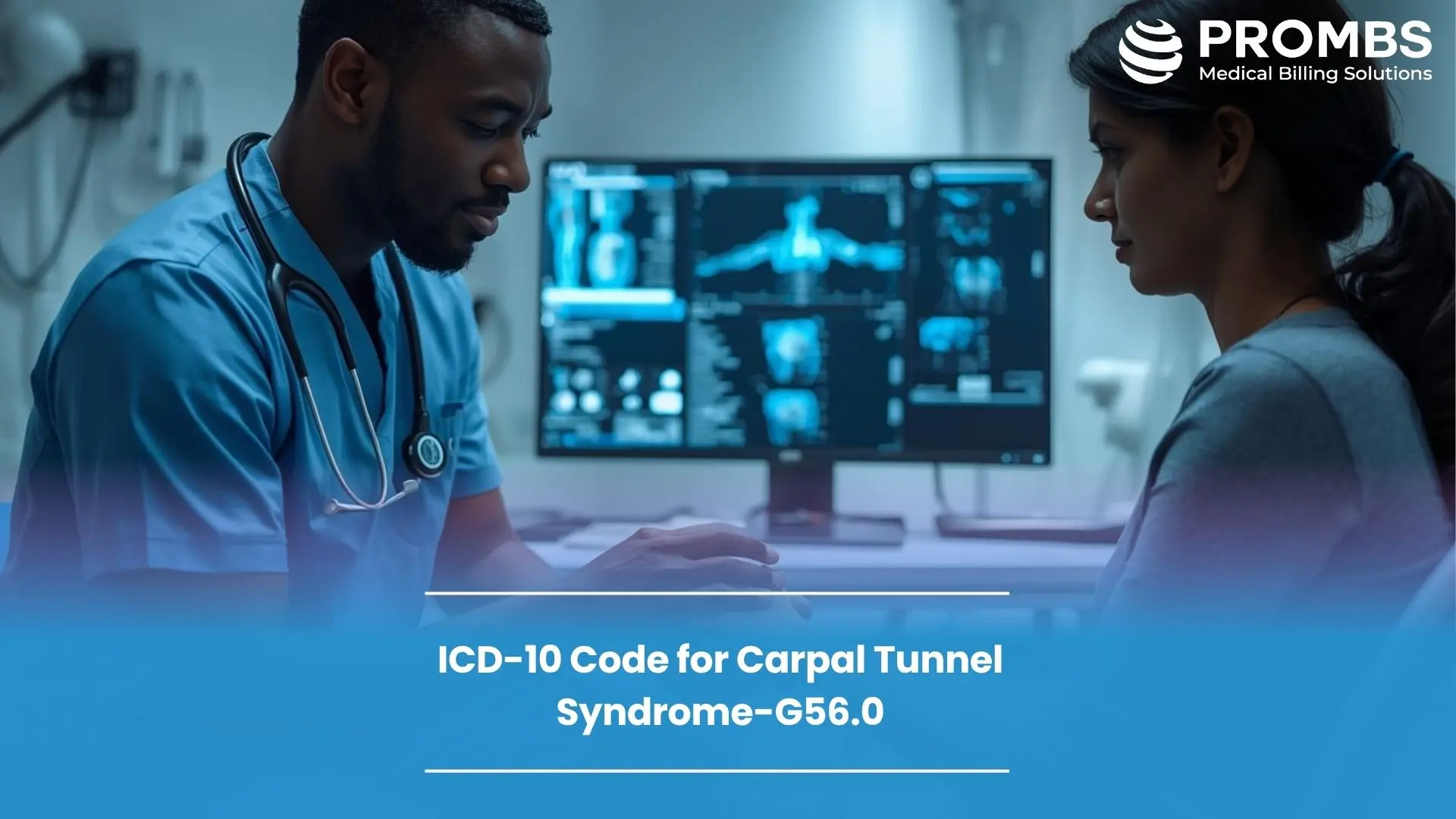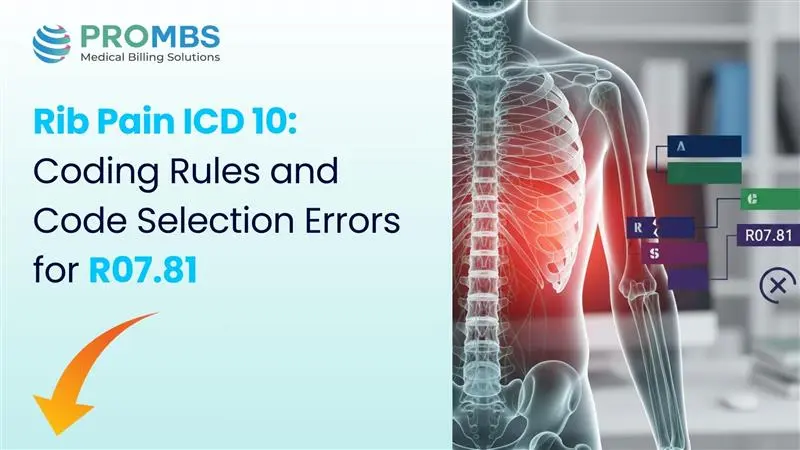Carpal Tunnel Syndrome (CTS) is a compressive neuropathy of the median nerve at the wrist, often caused by repetitive motion or chronic inflammation. It remains one of the most commonly reported work-related disorders in the United States, as highlighted by the National Institute of Neurological Disorders and Stroke (NINDS). In clinical practice, CTS leads to numbness, tingling, and weakness in the hands, symptoms that often necessitate nerve conduction testing, splinting, steroid injections, or surgery.
From a billing perspective, accurate coding for CTS ensures that each service, diagnostic or procedural, is linked to a specific diagnosis that supports medical necessity under CMS LCD policies. Since payers frequently review musculoskeletal and neurological claims for documentation clarity, precision in coding the icd 10 code for carpal tunnel syndrome (G56.0) becomes essential to avoid denials and post-payment audits. The American Health Information Management Association (AHIMA) emphasizes that vague documentation such as “hand pain” or “nerve entrapment” often results in unspecified codes that fail medical-necessity validation. Correctly linking the diagnosis with corresponding CPT codes ensures both compliance and clean claim submission, reflecting the provider’s clinical intent and protecting revenue integrity.
What Are the Common Symptoms of Carpal Tunnel Syndrome That Coders Should Recognize?
Clinically, CTS presents with pain, numbness, paresthesia, and weakness in the thumb, index, and middle fingers. According to the Mayo Clinic, these symptoms often worsen at night or with repetitive hand movement. For coders, identifying these hallmark features helps justify testing or treatment such as nerve conduction velocity (NCV) studies or carpal tunnel release procedures. The documentation should capture symptom duration, laterality (right, left, or bilateral), and any work-related triggers. Coders must ensure that provider notes explicitly describe “median nerve compression” or “entrapment at the carpal tunnel,” which directly supports G56.0 coding.
| Clinical Indicator | Documentation Requirement | Billing Value (with reference) |
|---|---|---|
| Paresthesia and numbness in thumb/index finger | Record symptom pattern and chronicity in both hands when present. | Required under AANEM Guidelines for electrodiagnostic justification. |
| Positive Tinel’s or Phalen’s test | Document physical exam maneuvers confirming nerve compression. | Establishes clinical necessity for CPT 95910 (NCV testing) under CMS LCD L34566. |
| Weak grip or muscle atrophy | Include degree of functional limitation in daily tasks. | Supports therapy or surgical intervention per AANS recommendations. |
| Symptom progression or nocturnal pain | Record aggravating and relieving factors, especially work-related motion. | Strengthens linkage to repetitive-strain ICD classification per NIOSH data. |
When providers document these details clearly, coders can confidently assign the icd 10 code for carpal tunnel syndrome (G56.0) and justify related services, creating a transparent trail that satisfies both clinical and payer logic.
Did You Know? The CDC’s National Center for Health Statistics (NCHS) reports that carpal tunnel procedures account for over 500,000 surgeries annually in the U.S., making it one of the most frequently coded peripheral nerve conditions in outpatient claims.
What Is the ICD-10 Code for Carpal Tunnel Syndrome and What Does It Mean?
The icd 10 code for carpal tunnel syndrome is G56.0- representing “Carpal Tunnel Syndrome” under Chapter VI of ICD-10-CM, Diseases of the Nervous System (G00–G99). The World Health Organization (WHO) designates G56.0 for median nerve compression at the wrist, regardless of etiology.
Laterality is specified with extensions:
- G56.01-Right upper limb
- G56.02-Left upper limb
- G56.03-Bilateral upper limbs
Accurate laterality coding is essential because payers like CMS and Blue Cross Blue Shield now require specificity for nerve compression conditions during claim processing. Documentation stating “bilateral CTS” should therefore translate to G56.03, while “right-hand CTS” should be coded G56.01. Each variation directly influences reimbursement and utilization review. For instance, when nerve conduction studies or carpal tunnel release procedures are performed on both hands, separate reporting is allowed only when laterality is clearly documented and reflected in the ICD-10 code.
| ICD-10 Code | Description | Use Case / Coverage Logic |
|---|---|---|
| G56.0 | Carpal tunnel syndrome, unspecified | Only if laterality not documented; avoid if side is known, per ICD-10-CM Official Guidelines FY2025. |
| G56.01 | Carpal tunnel syndrome, right upper limb | Document right-sided pain, weakness, and EMG/NCV results supporting right median nerve involvement per AANEM criteria. |
| G56.02 | Carpal tunnel syndrome, left upper limb | Use when symptoms and testing confirm left wrist nerve compression per AANEM diagnostic criteria. |
| G56.03 | Carpal tunnel syndrome, bilateral upper limbs | Document findings for both hands; justifies bilateral modifier (-50) under CPT and CMS coverage. |
Did You Know? The Office of Inspector General (OIG) found that nearly 18% of denied hand-surgery claims involved mismatched laterality documentation, underscoring why precise ICD-10 use directly safeguards compliance.
Did You Know? The Office of Inspector General (OIG) has repeatedly listed unspecified or miscoded heart failure among the top 10 findings in hospital compliance audits. In one 2023 OIG summary report, over 18% of denied cardiology claims cited lack of specificity in ICD-10 coding as the primary error. Correctly assigning I50.21, I50.22, or I50.23 not only improves reimbursement accuracy but also shields providers from compliance risk.
Which CPT Codes Pair with the ICD-10 Code for Carpal Tunnel Syndrome?
Correctly pairing the icd 10 code for carpal tunnel syndrome (G56.0-G56.03) with corresponding CPT procedure codes determines whether a claim is reimbursed or denied. The American Medical Association (AMA) defines carpal tunnel-related procedural codes as encompassing both diagnostic and surgical interventions. Diagnostic testing includes CPT 95910 for nerve conduction studies and CPT 95886 for EMG evaluation. Therapeutic management involves CPT 64721- neuroplasty and/or transposition of the median nerve at carpal tunnel (carpal tunnel release). Each must be supported by documentation describing symptoms, diagnostic findings, and treatment rationale.
| CPT Code | Procedure Description | Medical Necessity Support |
|---|---|---|
| 95910 | Nerve conduction study, 10 or more nerves | Requires clinical suspicion of median neuropathy documented under G56.0 per CMS LCD L34566. |
| 95886 | Needle electromyography, complete extremity study | Must reference EMG findings confirming CTS under AANEM standards. |
| 64721 | Neuroplasty and/or transposition of median nerve at carpal tunnel | Justified when conservative management fails, per AANS surgical guidelines. |
| 20526 | Injection, therapeutic (carpal tunnel) | Requires pre-procedure diagnosis G56.0 documented and linked in claim notes. |
These CPT pairings must align with ICD-10 G56.0–G56.03 and reflect medical necessity according to CMS National Coverage Determinations (NCDs). Claims missing a specific diagnosis-procedure linkage risk denial during pre-adjudication review. When coding for carpal tunnel release procedures, coders should confirm surgical laterality and apply appropriate modifiers (-RT, -LT, or -50) for bilateral operations.
Did You Know? The HFMA 2023 Compliance Benchmark Report revealed that 22% of outpatient orthopedic denials originated from incomplete ICD-CPT linkage-a gap ProMBS prevents through integrated claim validation before submission.
What Treatments Are Linked to Carpal Tunnel Syndrome and How Should They Be Documented?
Carpal tunnel syndrome treatment depends on severity. The American Academy of Orthopaedic Surgeons (AAOS) recommends conservative options, wrist splinting, corticosteroid injections, and occupational therapy, before progressing to surgical decompression. Each stage must be documented clearly in the EHR to justify procedure escalation. For example, if conservative management fails and a carpal tunnel release (CPT 64721) is performed, documentation should reflect prior therapy attempts and ongoing symptoms. This provides the payer with a clear treatment narrative, confirming that surgery was medically necessary. Including laterality and symptom persistence in every note ensures claims are
payer-defensible. The AHIMA documentation guidelines recommend describing both clinical response and time frame (“persistent pain for 3 months despite splinting”) for audit compliance.
Did You Know? According to the Agency for Healthcare Research and Quality (AHRQ), early coding of conservative management and later escalation to surgical CPTs can improve reimbursement tracking and continuity of care metrics for musculoskeletal programs.
How Should Documentation Be Structured to Avoid Denials?
Accurate documentation is the single most important factor in ensuring smooth claim approval for carpal tunnel syndrome under the icd 10 code for carpal tunnel syndrome (G56.0). The Centers for Medicare & Medicaid Services (CMS) lists musculoskeletal and nerve-compression claims among the most frequently denied categories in outpatient billing. These denials typically stem from incomplete notes, such as missing laterality, vague descriptors like “hand pain,” or absent diagnostic test results.
In every encounter note, the provider must document three essential components: the anatomical site, the diagnostic confirmation, and the treatment rationale. For example, documentation that states, “right-hand numbness due to median nerve compression confirmed by EMG, scheduled for right carpal tunnel release,” directly supports the diagnosis G56.01 and links to the procedure CPT 64721. The American Health Information Management Association (AHIMA) emphasizes that this narrative clarity satisfies both payer audit logic and ICD-10-CM specificity rules. Payers like Blue Cross Blue Shield and Cigna use automated “specificity edits” to identify noncompliant claims, while OIG auditors frequently flag CTS cases where diagnostic evidence (like a nerve conduction study) was not clearly documented. The best protection is proactive documentation that supports the clinical and procedural link between diagnosis and care.
| Documentation Gap | Why Denials Occur | Prevention Strategy |
|---|---|---|
| Missing laterality | Payers reject G56.0 when the side is not specified, citing lack of claim precision under ICD-10-CM Official Guidelines FY2025. | Always document “right,” “left,” or “bilateral” before claim submission. This ensures compliance with CMS coverage policies. |
| No diagnostic evidence | Claims fail audit review when EMG or NCV confirmation is missing, violating CMS LCD L34566. | Reference test results directly in the note, e.g., “EMG confirmed right median neuropathy,” aligning with AANEM testing standards. |
| Generic or nonspecific terminology | Terms like “hand pain” or “wrist discomfort” lead to medical-necessity denials under CMS’s Medical Review Guidelines. | Replace with “median nerve compression” or “carpal tunnel syndrome confirmed,” as defined by Mayo Clinic diagnostic criteria. |
| Procedure not linked to diagnosis | CPT 64721 or 20526 billed without diagnosis G56.0 fails crosswalk validation under CMS NCCI Edit Tables. | Ensure each CPT line links to the ICD-10 diagnosis via Medicare’s NCD Manual. |
| Lack of conservative management history | Surgery denials occur when documentation omits prior splinting, steroid injection, or therapy trials required by payer LCDs like LCD L37646. | Include a care timeline describing conservative management and failure, as recommended by the American Academy of Orthopaedic Surgeons (AAOS). |
This table demonstrates how payer audits evaluate documentation not only for the presence of a diagnosis but also for its clinical substantiation. Each prevention strategy aligns with specific regulatory or clinical bodies, ensuring traceability for compliance audits. The key for coders is to connect each narrative detail, from nerve test results to prior therapies, directly to the corresponding CPT and ICD-10 codes. When this workflow is applied consistently, claims coded with G56.0–G56.03 flow through adjudication seamlessly. ProMBS follows a three-tier compliance verification for every CTS claim: verifying anatomical specificity, cross-linking diagnostic findings, and confirming that all procedures reflect documented clinical necessity. This audit trail ensures every claim aligns with CMS’s “reasonable and necessary” rule, reducing the risk of post-payment recoupments.
Did You Know? The CMS CERT 2024 report found that 38% of denied musculoskeletal claims lacked laterality or failed to document pre-treatment management, issues entirely preventable with structured documentation protocols like those used by ProMBS.
Why Should Providers Partner with ProMBS for Carpal Tunnel Syndrome Billing?
In a high-volume specialty like orthopedics or neurology, even minor documentation gaps can translate into substantial revenue loss. At ProMBS, our coders and compliance analysts ensure that every claim built around the icd 10 code for carpal tunnel syndrome meets CMS, AHA, and AHIMA standards. We integrate automated ICD-CPT validation, payer-specific LCD cross-checks, and continuous staff training on orthopedic and neurology claim patterns. Every claim undergoes pre-submission review for laterality accuracy, EF or nerve-study confirmation, and modifier alignment, steps that dramatically reduce audit risk.
Beyond coding precision, our team helps practices maintain audit-ready documentation through education, feedback loops, and RCM dashboards. We specialize in converting complex neuromusculoskeletal data into clean, compliant, payer-ready claims that pass on first submission. In today’s regulatory climate, where every carpal tunnel claim is scrutinized for specificity, ProMBS provides unmatched assurance. We don’t just process claims, we protect compliance, optimize reimbursements, and help practices build transparent RCM systems that scale. When precision, compliance, and performance matter, ProMBS remains your trusted partner in transforming carpal tunnel syndrome billing from administrative complexity into predictable revenue success.



